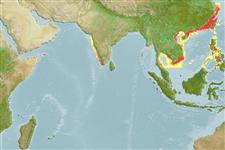Environment: milieu / climate zone / depth range / distribution range
Ecologia
marino; acqua dolce; salmastro; distribuzione batimetrica 0 - 50 m (Ref. 189). Tropical; 33°N - 7°N, 72°E - 124°E (Ref. 189)
Indo-Pacific: East and South China seas (from at least Suchow south to Hainan and most likely to Viet Nam), also Indian Ocean (Kerala, India).
Size / Peso / Age
Maturity: Lm ? range ? - ? cm
Max length : 33.0 cm SL maschio/sesso non determinato; (Ref. 124713); peso massimo pubblicato: 127.32 g (Ref. 124713)
Spine dorsali (totale): 0; Spine anali 0; Raggi anali molli: 80. Body tapering, belly rounded before pelvic fins, with 12 to 15 + 22 to 29 = 36 to 44 keeled scutes from isthmus to anus. Maxilla long, reaching to or beyond base of the first pectoral fin ray. Pectoral fin with 7 filaments. All other species with a long maxilla have only 6 pectoral filaments.
Occurs in coastal waters and estuaries, presumably with a biology similar to that of other members of the genus. Feed on zooplankton, small insects, crustaceans, and fish (Ref. 5258).
Life cycle and mating behavior
Maturità | Riproduzione | Deposizione | Uova | Fecundity | Larve
Spawn in school (Ref. 205).
Whitehead, P.J.P., G.J. Nelson and T. Wongratana, 1988. FAO Species Catalogue. Vol. 7. Clupeoid fishes of the world (Suborder Clupeoidei). An annotated and illustrated catalogue of the herrings, sardines, pilchards, sprats, shads, anchovies and wolf-herrings. FAO Fish. Synop. 125(7/2):305-579. Rome: FAO. (Ref. 189)
IUCN Red List Status (Ref. 130435)
Threat to humans
Harmless
Human uses
Pesca: pesca di sussistenza
Informazioni ulteriori
BibliografiaAcquacolturaProfilo di acquacolturaVarietàGeneticaElectrophoresesEreditarietàMalattieElaborazioneNutrientsMass conversion
CollaboratoriImmaginiStamps, Coins Misc.SuoniCiguateraVelocitàModalità di nuotoArea branchialeOtolithsCervelliVista
Strumenti
Special reports
Download XML
Fonti Internet
Estimates based on models
Preferred temperature (Ref.
123201): 23.6 - 28.6, mean 26.4 °C (based on 122 cells).
Phylogenetic diversity index (Ref.
82804): PD
50 = 0.5001 [Uniqueness, from 0.5 = low to 2.0 = high].
Bayesian length-weight: a=0.00229 (0.00142 - 0.00370), b=3.10 (2.97 - 3.23), in cm total length, based on LWR estimates for this species & Genus-body shape (Ref.
93245).
Trophic level (Ref.
69278): 3.4 ±0.5 se; based on size and trophs of closest relatives
Resilienza (Ref.
120179): Medio, tempo minimo di raddoppiamento della popolazione 1.4 - 4.4 anni (Preliminary K or Fecundity.).
Fishing Vulnerability (Ref.
59153): Low to moderate vulnerability (30 of 100).
